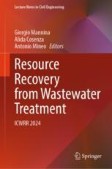Search
Search Results
-
Which Characteristics Make Drinking Water Treatment Residuals a Low-Cost Adsorbent?
Millions of tons of Drinking Water Treatment Residuals (DWTR) are daily produced globally that mainly end up in landfills. The use of DWTR as an...
-
Microbial genome (Illumina MiSeq) sequencing of drinking water treatment residuals to evaluate compatibility with environmental applications
The clarification of drinking water leads to the production of large quantities of water treatment residuals (WTRs). DNA was extracted from six WTR...

-
Challenges and opportunities for drinking water treatment residuals (DWTRs) in metal-rich areas: an integrated approach
The physicochemistry and production rate of drinking water treatment residuals (DWTRs) depends on the raw water composition and the plant operational...

-
Modelling chlorine residuals in drinking water: a review
World Health Organization’s guidelines on water quality limit concentrations of residual chlorine in drinking water to the range 0.2–5 mg/l....

-
Point-of-use filtration units as drinking water distribution system sentinels
Municipal drinking water distribution systems (DWDSs) and associated premise plumbing (PP) systems are vulnerable to proliferation of opportunistic...

-
Evaluation and characterisation of metal sorption and retention by drinking water treatment residuals (WTRs) for environmental remediation
Drinking water treatment residuals (WTRs) are wastes generated when water is clarified using aluminium or iron salts. They are increasingly being...

-
Optimal pricing of drinking water based on the average household income using a system dynamics approach
Proper planning, management of water resources, and improvement and development of management methods of water and sewerage network are essential for...

-
Investigation of Pumpkin Seed as a Potential Coagulant for Drinking Water Treatment
Studies pointed out that using synthetic chemical coagulants for water purification presents health and environmental problems. Because of this,...

-
Using Pgst-4::GFP-transformed Caenorhabditis elegans for drinking water quality monitoring
Biological effect-based monitoring is essential for predicting or alerting to a possible deterioration in drinking water quality. In the present...

-
Trihalomethanes in drinking water from three First Nation reserves in Manitoba, Canada
Previous research indicates that the water distribution system used has a significant impact on the microbial quality of tap water sampled in First...

-
Succession of bacterial biofilm communities following removal of chloramine from a full-scale drinking water distribution system
Monochloramine is used to regulate microbial regrowth in drinking water distribution systems (DWDS) but produces carcinogenic disinfection byproducts...

-
Light-dominated selection sha** filamentous cyanobacterial assemblages drives odor problem in a drinking water reservoir
Filamentous cyanobacteria have substantial niche overlap, and the causal mechanism behind their succession remains unclear. This has practical...

-
Evaluation of mortality among Marines, Navy personnel, and civilian workers exposed to contaminated drinking water at USMC base Camp Lejeune: a cohort study
BackgroundDrinking water at U.S. Marine Corps Base (MCB) Camp Lejeune, North Carolina was contaminated with trichloroethylene and other industrial...
-
Integration of high-rate filtration using waste-derived biochar as a potential sustainable technology for drinking water supply
This research aimed to evaluate the efficiency of eucalyptus (E) and bamboo (B) residual biomass biochars as filter materials for drinking water...

-
Satellite assessment of eutrophication hot spots and algal blooms in small and medium-sized productive reservoirs in Uruguay’s main drinking water basin
Intensive agricultural activities favor eutrophication and harmful phytoplankton blooms due to the high export of nutrients and damming of rivers....

-
Drinking water elements constituent profiles and health risk assessment in Wuxi, China
Water elements pollution has attracted public attention globally. Wuxi is located in East China, and its water source, Taihu Lake, has been severely...

-
Acute health effects associated with satellite-determined cyanobacterial blooms in a drinking water source in Massachusetts
BackgroundThe occurrence of cyanobacterial blooms in freshwater presents a threat to human health. However, epidemiological studies on the...

-
Hydroxylamine facilitated catalytic degradation of methylene blue in a Fenton-like system for heat-treatment modified drinking water treatment residues
Rational treatment of drinking water treatment residues (WTR) has become an environmental and social issue due to the risk of secondary...

-
A review of data-driven modelling in drinking water treatment
There are significant opportunities to optimize drinking water treatment and water resource management using data-driven models. Modelling can help...

-
Potential use of nanoparticles produced from byproducts of drinking water industry in stabilizing arsenic in alkaline-contaminated soils
The stabilization of heavy metals in soils is considered a cost-effective and environmentally sustainable remediation approach. In the current study,...

